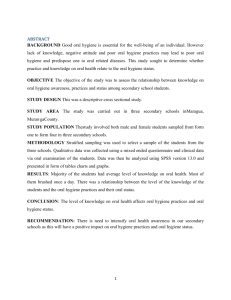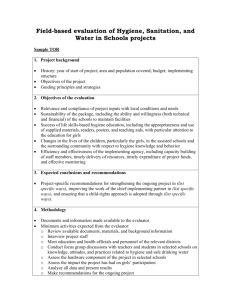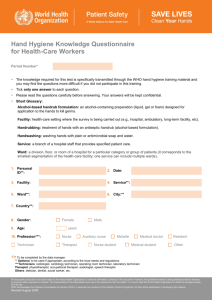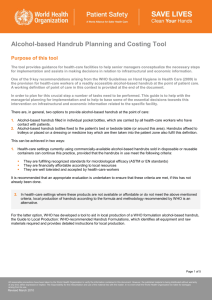Questionnaire on hand hygiene and healthcare
advertisement
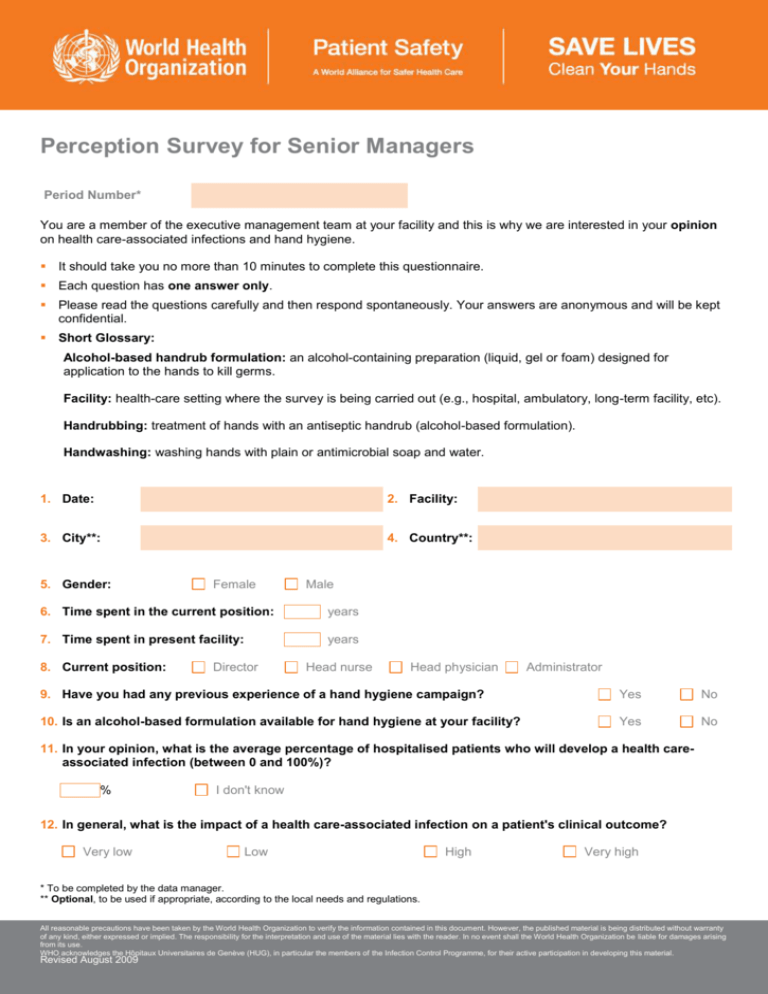
Perception Survey for Senior Managers Period Number* You are a member of the executive management team at your facility and this is why we are interested in your opinion on health care-associated infections and hand hygiene. It should take you no more than 10 minutes to complete this questionnaire. Each question has one answer only. Please read the questions carefully and then respond spontaneously. Your answers are anonymous and will be kept confidential. Short Glossary: Alcohol-based handrub formulation: an alcohol-containing preparation (liquid, gel or foam) designed for application to the hands to kill germs. Facility: health-care setting where the survey is being carried out (e.g., hospital, ambulatory, long-term facility, etc). Handrubbing: treatment of hands with an antiseptic handrub (alcohol-based formulation). Handwashing: washing hands with plain or antimicrobial soap and water. 1. Date: 2. Facility: 3. City**: 4. Country**: 5. Gender: Female Male 6. Time spent in the current position: years 7. Time spent in present facility: years 8. Current position: Director Head nurse Head physician Administrator 9. Have you had any previous experience of a hand hygiene campaign? Yes No 10. Is an alcohol-based formulation available for hand hygiene at your facility? Yes No 11. In your opinion, what is the average percentage of hospitalised patients who will develop a health careassociated infection (between 0 and 100%)? % I don't know 12. In general, what is the impact of a health care-associated infection on a patient's clinical outcome? Very low Low High Very high * To be completed by the data manager. ** Optional, to be used if appropriate, according to the local needs and regulations. All reasonable precautions have been taken by the World Health Organization to verify the information contained in this document. However, the published material is being distributed without warranty of any kind, either expressed or implied. The responsibility for the interpretation and use of the material lies with the reader. In no event shall the World Health Organization be liable for damages arising from its use. WHO acknowledges the Hôpitaux Universitaires de Genève (HUG), in particular the members of the Infection Control Programme, for their active participation in developing this material. Revised August 2009 13. In general, what is the impact of a health care-associated infection on the facility expenditures? Very low Low High Very high 14. What is the effectiveness of hand hygiene in preventing health care-associated infection? Very low Low High Very high 15. Among all patient safety issues, how important is hand hygiene within your management priorities at your facility? Low priority Moderate priority High priority Very high priority 16. On average, in what percentage of situations requiring hand hygiene do health-care workers in your facility actually perform hand hygiene, either by handrubbing or handwashing (between 0 and 100%)? % I don't know 17. Are senior nurses and doctors good examples for the promotion of hand hygiene at your facility? --- Not at all --- --- --- --- --- Very good 18. Is it common practice to inform patients about the importance of optimal hand hygiene during health-care delivery at your facility? Yes No 19. How do you consider the effort required by health-care workers to perform good hand hygiene when caring for patients at your facility? --- No effort --- --- --- --- --- A big effort 20. How do health-care workers perceive your request to perform optimal hand hygiene during patient care at your facility? --- Of little importance --- --- --- --- --- Very important 21. In your opinion, how effective would the following actions be to increase hand hygiene compliance permanently in your facility? Please tick one “ ” on the scale according to your opinion. a. Leaders and senior executive managers (you) at your facility support and openly promote hand hygiene. Not effective --- --- --- --- --- --- Very effective b. The health-care facility makes alcohol-based handrub available at each point of care. Not effective c. --- --- --- --- --- --- Very effective Hand hygiene posters are displayed at point of care as reminders. Not effective --- --- --- --- --- --- Very effective All reasonable precautions have been taken by the World Health Organization to verify the information contained in this document. However, the published material is being distributed without warranty of any kind, either expressed or implied. The responsibility for the interpretation and use of the material lies with the reader. In no event shall the World Health Organization be liable for damages arising from its use. WHO acknowledges the Hôpitaux Universitaires de Genève (HUG), in particular the members of the Infection Control Programme, for their active participation in developing this material. d. Each health-care worker receives education on hand hygiene. Not effective --- --- --- --- --- --- Very effective e. Clear and simple instructions for hand hygiene are made visible for every health-care worker. Not effective f. --- --- --- --- --- --- Very effective Health-care workers regularly receive the results of their hand hygiene performance. Not effective --- --- --- --- --- --- Very effective g. Senior nurses and doctors perform hand hygiene perfectly (being a good example for health-care workers at your facility) Not effective --- --- --- --- --- --- Very effective h. Patients are invited to remind health-care workers to perform hand hygiene. Not effective --- --- --- --- --- --- Very effective Thank you very much for your time! All reasonable precautions have been taken by the World Health Organization to verify the information contained in this document. However, the published material is being distributed without warranty of any kind, either expressed or implied. The responsibility for the interpretation and use of the material lies with the reader. In no event shall the World Health Organization be liable for damages arising from its use. WHO acknowledges the Hôpitaux Universitaires de Genève (HUG), in particular the members of the Infection Control Programme, for their active participation in developing this material.




